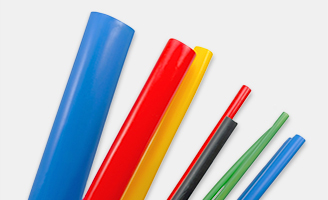
Heat shrink tubing is a common method used for insulation and protection of wires and cables throughout many industries. Its many beneficial properties make it an exceptionally useful material for a variety of applications. From covering wire harnesses and component packaging to organizing and protecting, heat shrink tubing serves different functions and purposes that can improve the performance, durability, and maintenance of products.
What is Heat Shrink Tubing?
Heat shrink tubing covers and encases a collection of wires, cables, or other components in a protective insulated tube from external disturbances. Heat shrinking uniquely adheres to products and provides a resilient protective shield with properties resistant to harsh environments that many applications function in.
Whether for added value, security, safety, or protection, here are five reasons companies should consider using heat shrink tubing for their applications.
1. ProtectionOne of the prime benefits of heat shrink tubing is the protection offered to wires and cables when exposed to a variety of conditions and environments. In factories and manufacturing plants, wires and cables are subject to abrasion, scuffing, splitting, and constant wear when left exposed. Other factors in production environments can expose cabling to water or moisture such as steam, oils, grease, chemicals and acids. Outdoors, humidity, temperature fluctuation, rain, UV exposure and environmental conditions in general can damage wiring and cabling. Heat shrink tubing can help ensure the continued performance of wiring and cables.
2. Insulation Properties
Insulation of electrical wires and cables is first and foremost required to prevent electrical shock. However, the insulation of wires and cables also prevents the loss and dissipation of energy being conducted through the wiring. The material properties of cable insulators are non-conductive and designed to provide a buffer with anyone or anything that may come in contact with the cabling. Also, thicker insulation provides greater resistance and better transmission of the energy being conducted or information being transmitted. Heat shrink tubing adds a layer of insulation to help the resistance and adds another level of safety.
3. Reduces Cable Stress
Though heat shrink tubing offers protection for cabling and wiring from exposure to environmental conditions, it also aids in preventing undue strain or stretching of wires and cables confined to insufficient space or length. Heat shrinking increases mechanical support for maintaining connectivity of wires and cables that otherwise would be subjected to strain and stress that could lead to premature failure.
4. Organization
There may be no better argument for the application of heat shrink tubing of wires, cabling, and components than to organize them. Bundling wires and cables are not only aesthetically pleasing, but good cable management allows for easy access during maintenance of the system.
5. Corrosion Resistance
Over time, in any environment, when oxygen combines with the metal it forms a new compound called oxide that weakens the bonds of the metal itself, causing it to corrode. Metals and their alloys used in wiring and cable applications can be made corrosion-resistant, but only insulating the material can ensure against corrosion. Heat shrink tubing perfectly seals and protects wires and cabling from corrosion that might occur from external disturbances.
To meet your heat shrinking needs, M.M. Newman Corporation offers PVC and polyolefin heat shrink tubing that meets and exceeds industry standards and serves a variety of industrial and defense-related applications. PVC is a flexible material that easily forms a snug-fitting, smooth insulated surface over most applications. Its many properties include UV resistance, antifungal, protection against moisture, and it is chemical and oil resistant. A low shrink temperature of less than 200°F provides an added dielectric and mechanical protection without damage to adjacent or enclosed components.
Polyolefin heat shrink is a lightweight, flexible heat shrink material that offers superior flame resistance complemented with outstanding electrical, chemical, and physical properties. It functions continuously in environments up to 275°F and will perform at elevated temperatures up to 572°F for short intervals, making it desirable for high heat applications. Its lightweight makes it a suitable wire-harness covering, and its fire resistance provides an ideal component packaging or covering. Heat shrink tubing applications provide insulation and protection in any environmental condition, reduces wear and tear, ensure continued performance, and can effectively bundle and organize them. For easier access and identification, M.M. Newman Corporation’s heat shrink tubing can be manufactured in clear as well as a number of standard colors.

